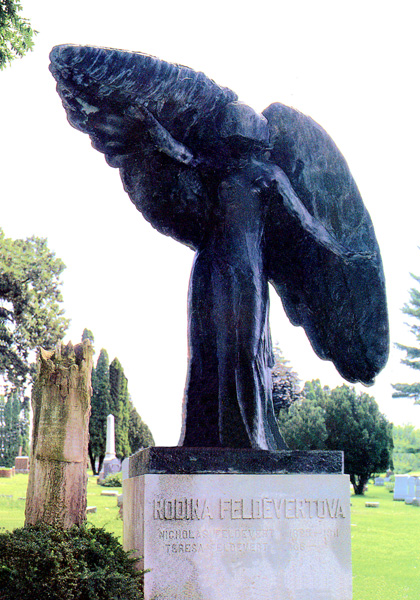Saturday Postcard 203: The Black Angel of Oakland Cemetery
A
popular enigma among a sea of gravestones in Iowa City’s Oakland Cemetery,
the Black Angel has witnessed
weddings, séances, fraternity pranks, fireworks, beer parties, funerals and
ceremonies stranger than the fictional
tales told about her creation and existence. Yet, she maintains her dignity
– and silence.
|
By Bob Hibbs
Strange graveyard tales are told and retold about things and events in Iowa City’s 15,000-grave Oakland Cemetery, but few are told as often, as varied or as uniquely embellished as those featuring the Black Angel.
In fact, since she has been known to generations of University of Iowa students for the better part of a century, she may be among the most widely-recognized grave markers in the Midwest, more familiar even of the plain slab marking the grave of former U.S. President Herbert Hoover in West Branch.
She incarnates a mother’s desperate love for a son who died at age 18 in 1891. But, students claim no woman is a true UI coed unless she had been kissed beneath the Black Angel, preferably at midnight. Fraternity members claim that if such a coed is “innocent of men” the statue will turn white. Nobody ever said myths were fair!
She stretches up nine feet above a three-foot stone pedestal, giving her a towering dominance over surrounding makers. She is almost coal black, but with blue-green highlights. She suffers the indignity of birdlime which crows and other species insist on depositing along her wings.
The indignities of vandals have left her with broken fingers, and a marred face. But, given her age, she has stood remarkably well the long test of guarding the graves of son, mother and husband, “rodina feldevertova,” as the base stone proclaims: “The Feldevert Family.”
She dates to 1912, executed by young Bohemian artist J. Mario Korbel in Chicago before he became famous in New York. She was cast for him by the Florentine Brotherhood, and arrived Nov. 21, 1912, at the “plug line” railroad depot then located along Ralston Creek behind what is now the Iowa City Recreation Center.
It is unclear whether the statue set in a warehouse until 1918 when the purchaser lost a lawsuit to the artist, or whether the angel took residence in the cemetery more immediately as reported Rose Zetek who lived nearly a century-long lifetime in a large brick house overlooking the Black Angel site from the north end of Reno Street.
The late Miss Zetek said that as a little girl in 1913 she watched an ox cart deliver the angel to the cemetery. Other local oral histories reported the same scene at about the same time. Other accounts report a 1918 date.
The bronze statue was a $5,000 commission by Teresa Dolezal Feldevert, who had been an immigrant to the Goosetown neighborhood of Iowa City, perhaps as early as the 1860s at a time when Bohemian custom had women retain maiden names after marriage.\ Although trained in medicine in Europe, she had no documentation and received a midwifery license here. She had a son, Eddie Dolezal, whose father is a mystery.
The son was working as a pharmacy clerk when he became ill with meningitis and died in 1891. Initially he was buried about 450 feet west of the angel site, the spot marked by a stone monument in the form of a tree trunk, a marker which now stands beside the Angel.
Teresa met and married wealthy rancher Nicholas Feldevert and settled at Eugene, Oregon. After his death in 1911, she returned to Iowa City where she resided until her death from cancer in 1924, spending her latter years in a wheel chair. Her ashes were buried beneath the slab in front the angel, joining those of her husband and son, whose body she had had exhumed, cremated and moved after the angel was erected.
Bronze, a mixture of mostly copper with a small amount of tin, naturally ages in the elements to the blue-black color exhibited by the statue today. But, never mind science, legends persist. Like the one about lightning striking the statue after the husband’s funeral, turning it instantly black.
With mystery surrounding the boy’s father, there also are tales claiming infidelity caused the blackness.
Regardless, she is a famous lady in an unusual head-bowed pose as if favoring the son’s gravesite.
Next Saturday: Butler’s Capitol – the first capitol in Iowa City.
Bob Hibbs collects local postcards and researches history related to them.
|
